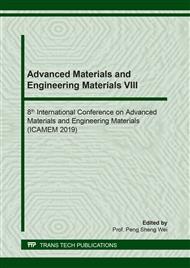[1]
P. R. Meghwal, S.K. Singh, A. Singh, R. Pathak, Characterization of Karonda (Carissa carandas) accessions under arid region, Journal of Applied Horticulture 2 (2014) 157-160.
DOI: 10.37855/jah.2014.v16i02.28
Google Scholar
[2]
J. Sueprasarn, S. Reabroy, T. Pirak, Antioxidant properties of Karanda (Carissa carandas Linn.) extracts and its application in Thai traditional fermented pork sausage (Nham), Int. Food Res. J. 4 (2017) 1667-1675.
Google Scholar
[3]
M. Arif, M. Kamal, T. Jawaid, M. Khalid, K.S. Saini, A. Kumar, M. Ahmad, Carissa carandas Linn. (Karonda): An exotic minor plant fruit with immense value in nutraceutical and pharmaceutical industries, AJBPS 58 (2016) 14-19.
Google Scholar
[4]
Y. Sudjaroen, Lack of in vitro anticancer and antimicrobial activities from Karanda (Carissa carandas) fruit extracts., J. Pharm Negative Results 8 (2017) 31-36.
DOI: 10.4103/jpnr.jpnr_5_17
Google Scholar
[5]
R. Sarkar, A. Kundu, K. Banerjee, S. Saha, Anthocyanin composition and potential bioactivity of karonda (Carissa carandas L.) fruit: An Indian source of biocolorant, LWT - J. Food Sci. Technol. 93 (2018) 673-678.
DOI: 10.1016/j.lwt.2018.04.012
Google Scholar
[6]
S. Kumar, P. Gupta, and K.L.V. Gupta A Critical Review on Karamarda (Carissa carandas Linn.)., Int. J. Biol. Pharm. Allied. Sci. 4 (2013) 637-642.
Google Scholar
[7]
W. Pewlong, S. Sajjabut, J. Eamsiri, S. Chookaew, Evaluation of Antioxidant activities, Anthocyanins, Total Phenolic Content, Vitamin C Content and Cytotoxicity of Carissa carandas Linn., CMUJ NS Special Issue on Food and Applied Bioscience 13 (2014) 509-517.
DOI: 10.12982/cmujns.2014.0053
Google Scholar
[8]
A. Castañeda-Ovando, M.L. Pacheco-Hernández, M.E. Páez-Hernández, J.A. Rodríguez, C.A. Galán-Vidal, Chemical studies of anthocyanins: A review, Food Chem.s113 (2009) 859-871.
DOI: 10.1016/j.foodchem.2008.09.001
Google Scholar
[9]
P. Ongkowijoyo, D.A. Luna-Vital, E. Gonzalez de Mejia, Extraction techniques and analysis of anthocyanins from food sources by mass spectrometry: An update, Food Chem. 250 (2018) 113-126.
DOI: 10.1016/j.foodchem.2018.01.055
Google Scholar
[10]
L. Jaakola, New insights into the regulation of anthocyanin biosynthesis in fruits, Trends. Plant. Sci. 18 (2013) 477-483.
DOI: 10.1016/j.tplants.2013.06.003
Google Scholar
[11]
J. Fang, Classification of fruits based on anthocyanin types and relevance to their health effects, Nutrition 31 (2015) 1301-1306.
DOI: 10.1016/j.nut.2015.04.015
Google Scholar
[12]
V. Gowd, Z. Jia, W. Chen, Anthocyanins as promising molecules and dietary bioactive components against diabetes – A review of recent advances, Trends. Food Sci. Technol. 68 (2017) 1-13.
DOI: 10.1016/j.tifs.2017.07.015
Google Scholar
[13]
A. Rafaela C. Braga, D.C. Murador, L.M.S. Mesquita, V.V. Rosso, Bioavailability of anthocyanins: Gaps in knowledge, challenges and future research, J. Food Compos. Anal. 68 (2018) 31-40.
DOI: 10.1016/j.jfca.2017.07.031
Google Scholar
[14]
C.A. Morais, V.V. Rosso, D. Estadella, L. Pellegrini Pisani, Anthocyanins as inflammatory modulators and the role of the gut microbiota, J. Nutr. Biochem. 33 (2016) 1-7.
DOI: 10.1016/j.jnutbio.2015.11.008
Google Scholar
[15]
J.M. Kong, L.S. Chia, N.K. Goh, T.F. Chia, R. Brouillard, Analysis and biological activities of anthocyanins, Phytochemistry 64 (2003) 923-933.
DOI: 10.1016/s0031-9422(03)00438-2
Google Scholar
[16]
K. Mahdavee Khazaei1 & S. M. Jafari1,2,4 & M. Ghorbani1 & A. Hemmati Kakhki3 & M. Sarfarazi, Optimization of Anthocyanin Extraction from Saffron Petals with Response Surface Methodology, Food Anal. Methods 9 (2016) 1993–(2001).
DOI: 10.1007/s12161-015-0375-4
Google Scholar
[17]
B. Guldiken, D. Boyacioglu, E. Capanoglu, Optimization of Extraction of Bioactive Compounds from BlackCarrot Using Response Surface Methodology (RSM), Food Anal. Methods 9 (2016) 1876–1886.
DOI: 10.1007/s12161-015-0370-9
Google Scholar
[18]
G.L. Liu, H.H. Guo, Y.M. Sun, Optimization of the Extraction of Anthocyanins from the Fruit Skin of Rhodomyrtus tomentosa (Ait.) Hassk and Identification of Anthocyanins in the Extract Using High-Performance Liquid Chromatography-Electrospray Ionization-Mass Spectrometry (HPLC-ESI-MS), Int. J. Mol. Sci. 13 (2012), 6292-6302.
DOI: 10.3390/ijms13056292
Google Scholar
[19]
T.B. Zou, M. Wang, R.Y. Gan, W.H. Ling, Optimization of Ultrasound-Assisted Extraction of Anthocyanins from Mulberry, Using Response Surface Methodology, Int. J. Mol. Sci. 12 (2011), 3006-3017.
DOI: 10.3390/ijms12053006
Google Scholar
[20]
G. Fan, Y. Han, Z. Gu, D. Chen, Optimizing conditions for anthocyanins extraction from purple sweet potato using response surface methodology (RSM), LWT - Food Science and Technology 41 (2008) 155–160.
DOI: 10.1016/j.lwt.2007.01.019
Google Scholar
[21]
H. Guo, W. Ling, Q. Wang, C. Liu, Y. Hu, M. Xia, X. Feng, X. Xia, Effect of anthocyanin-rich extract from black rice (Oryza sativa L. indica) on hyperlipidemia and insulin resistance in fructose-fed rats. Plant Foods Hum. Nutr. 62 (2007), 1–6.
DOI: 10.1007/s11130-006-0031-7
Google Scholar
[22]
J. Lee, R.W. Durst, R.E. Wrolstad, Determination of total monomeric anthocyanin pigment content of fruit juices, beverages, natural colorants, and wines by the pH differential method: Collaborative study. J. AOAC Int. 88 (2005) 1269–1278.
DOI: 10.1093/jaoac/88.5.1269
Google Scholar
[23]
Z. Yang, W. Zhai, Optimization of microwave-assisted extraction of anthocyanins from purple corn (Zea mays L.) cob and identification with HPLC-MS. Innov. Food Sci. Emerg. 11( 2010) 470–476.
DOI: 10.1016/j.ifset.2010.03.003
Google Scholar
[24]
H.L. Man, S. Behera, H. Park, Optimization of operational parameters for ethanol production from Korean food waste leachate. Int. J. Environ. Sci. Technol. 7 (2010) 157–164.
DOI: 10.1007/bf03326127
Google Scholar
[25]
B. Chauhan, R. Gupta, Application of statistical experimental design for optimization of alkaline protease production from Bacillus sp. RGR-14. Process. Biochem. 39 (2004) 2115–2122.
DOI: 10.1016/j.procbio.2003.11.002
Google Scholar


